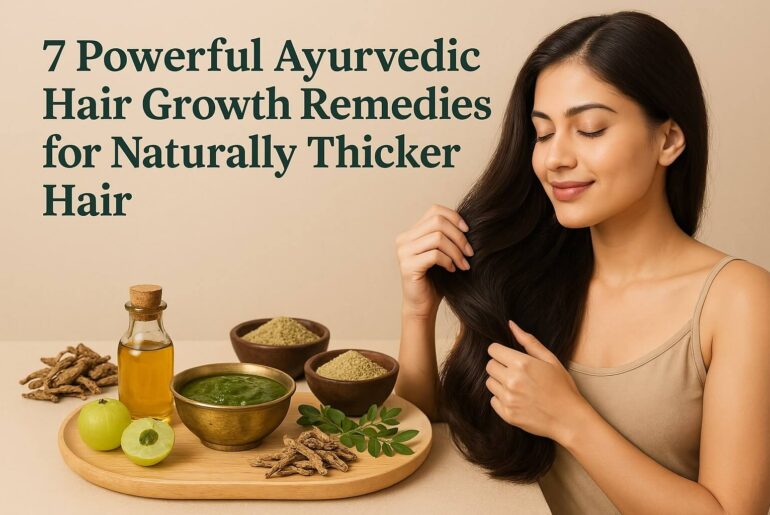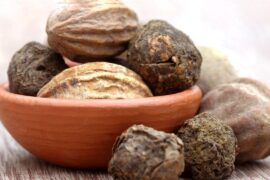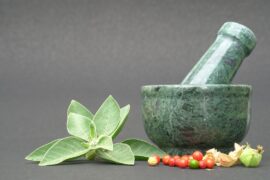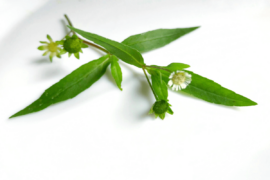Are you tired of trying endless hair products that promise miracles but deliver disappointment? You’re not alone. In my journey exploring natural hair solutions, I’ve discovered that Ayurvedic hair growth remedies offer something different – treatments backed by thousands of years of traditional wisdom that actually work.
Ayurvedic hair care isn’t just about applying herbs to your scalp; it’s a holistic approach that addresses the root causes of hair problems by balancing your body’s natural energies or doshas. These time-tested techniques can transform thin, lifeless strands into thicker, more vibrant hair without harsh chemicals.
The global hair care market is projected to grow at a CAGR of 3.2% from 2023 to 2028, with natural and Ayurvedic products representing one of the fastest-growing segments. Why? Because more people are discovering what ancient civilizations knew all along – nature provides everything we need for beautiful hair.
In this comprehensive guide, I’ll walk you through the most effective Ayurvedic hair growth remedies that can help you achieve the luscious locks you’ve always wanted. Whether you’re dealing with thinning hair, premature graying, or simply want to enhance your hair’s natural beauty, these techniques will put you on the path to healthier hair.
Understanding Hair Health Through Ayurveda
Before diving into specific remedies, it’s essential to understand how Ayurveda views hair health. According to this ancient system, your hair’s condition directly reflects your internal well-being and dosha balance.
How Doshas Affect Your Hair
In Ayurveda, everything is composed of the five elements – space, air, fire, water, and earth – which combine to form three doshas: Vata, Pitta, and Kapha. Your dominant dosha determines your hair’s natural characteristics:
Vata Hair (Air + Space):
- Naturally dry, thin, and frizzy
- Prone to breakage and split ends
- Gets tangled easily
- May have uneven growth patterns
- When imbalanced: excessive dryness, brittleness, and hair loss
Pitta Hair (Fire + Water):
- Medium thickness with fine strands
- Tends to be straight or with soft waves
- Prone to premature graying and hair thinning
- May have an oily scalp
- When imbalanced: excess oiliness, inflammation, and premature balding
Kapha Hair (Water + Earth):
- Thick, strong, lustrous, and wavy
- Tends to be oily but well-hydrated
- Grows abundantly and quickly
- When imbalanced: excessive oiliness, dandruff, and heaviness
Understanding your hair’s dosha type is the first step toward creating an effective Ayurvedic hair care routine. Is your hair naturally dry and prone to breakage? You likely have Vata-dominant hair. Is it thinning at the crown with some premature graying? That sounds like Pitta imbalance. Thick hair with stubborn dandruff? That’s classic Kapha.
Root Causes of Hair Problems in Ayurveda
Ayurveda looks beyond symptoms to address underlying causes. As Dr. Vasant Lad, renowned Ayurvedic physician, explains: “According to Ayurvedic principles, by understanding oneself, by identifying one’s own constitution, and by recognizing sources of doshic aggravation, one can not only follow the proper guidelines to cleanse, purify, and prevent disease, but also uplift oneself into a realm of awareness previously unknown.”
Common root causes of hair problems include:
Stress and Mental Factors: Chronic stress disrupts hormone balance and restricts blood flow to the scalp, leading to hair fall and stunted growth.
Dietary Imbalances: Lack of essential nutrients or consuming foods inappropriate for your dosha type can manifest as hair problems.
Poor Digestion (Agni): In Ayurveda, proper digestion is crucial for nutrient absorption and elimination of toxins. When digestion is compromised, hair health suffers.
External Factors: Environmental pollutants, harsh chemical treatments, and inappropriate hair products can damage hair structure.
By addressing these root causes while applying targeted Ayurvedic remedies, you’ll create the ideal conditions for healthy hair growth from the inside out.
7 Powerful Ayurvedic Herbs for Hair Growth
Now that we understand the Ayurvedic approach to hair health, let’s explore the most effective herbs for promoting hair growth and addressing common problems.
Bhringraj: The King of Hair Herbs
Known as the “king of herbs” for hair care, Bhringraj (Eclipta alba) lives up to its royal title. This remarkable herb has been a cornerstone of Ayurvedic hair treatments for centuries.
Benefits for hair growth:
- Stimulates dormant hair follicles
- Strengthens hair roots
- Prevents premature graying
- Conditions and adds natural shine
A 2008 study published in the Journal of Ethnopharmacology found that Bhringraj extract significantly increased hair follicle length and hair growth in test subjects. The study noted that petroleum ether extracts of Bhringraj showed better hair growth activity than ethanol extracts, demonstrating the herb’s potent properties.
How to use Bhringraj:
- Bhringraj Oil Massage: Warm Bhringraj oil and massage gently into your scalp. Leave overnight for best results.
- Bhringraj Powder Hair Mask: Mix Bhringraj powder with warm water to form a paste. Apply to scalp and hair, leave for 30 minutes, then rinse.
- Bhringraj Tea Rinse: Steep Bhringraj leaves or powder in hot water, cool, and use as a final rinse after shampooing.
Amla: Nature’s Hair Strengthener
Amla (Indian Gooseberry) is one of nature’s richest sources of vitamin C, containing 20 times more vitamin C than an orange. This potent antioxidant powerhouse works wonders for hair health.
Benefits for hair:
- Strengthens hair follicles
- Prevents premature graying
- Reduces hair fall
- Enhances hair pigmentation
- Stimulates blood circulation to the scalp
Clinical research has shown that amla extract stimulates hair growth and improves hair texture. A study published in the Journal of Medicinal Plants Studies demonstrated that regular application of amla-based hair formulations significantly increased hair thickness and reduced hair fall.
How to use Amla:
- Amla Oil Treatment: Massage warm amla oil into your scalp and hair. Cover with a warm towel for deeper penetration.
- Amla Hair Pack: Mix amla powder with yogurt and honey to form a paste. Apply to hair, leave for 45 minutes, then rinse.
- Amla Juice Rinse: Dilute amla juice with water and use as a final rinse to add shine and strength.
Brahmi: Nourishment for Hair Follicles
Brahmi (Bacopa monnieri) is revered in Ayurveda for its brain-boosting properties, but it’s equally effective for hair health. It calms the mind while nourishing the scalp.
Benefits for hair:
- Strengthens hair roots
- Improves blood circulation to the scalp
- Reduces hair fall
- Helps maintain natural hair color
- Soothes the scalp
According to a study from Flebo Health, “Brahmi is considered the best herb for hair regrowth as it effectively activates the protein in the body. One can attain long, beautiful, healthy hair if they regularly use Brahmi oil on their scalp.”
How to use Brahmi:
- Brahmi Oil Massage: Apply Brahmi oil to your scalp and gently massage in circular motions. Leave for at least an hour before washing.
- Brahmi Hair Mask: Mix Brahmi powder with aloe vera gel to form a paste. Apply to scalp and hair, leave for 30 minutes, then rinse.
- Brahmi-Infused Water Rinse: Steep Brahmi leaves in hot water overnight, strain, and use as a hair rinse after shampooing.
Additional Powerful Herbs
While Bhringraj, Amla, and Brahmi form the holy trinity of Ayurvedic hair care, several other herbs offer remarkable benefits:
Hibiscus: Rich in amino acids and vitamin C, hibiscus promotes thicker hair growth and prevents premature graying. Crush fresh flowers and leaves with water to create a natural hair conditioning mask.
Fenugreek (Methi): Packed with proteins and nicotinic acid, fenugreek strengthens hair follicles and combats dandruff. Soak the seeds overnight, grind them into a paste, and apply to your scalp.
Neem: With powerful antimicrobial properties, neem cleanses the scalp, treats dandruff, and creates an optimal environment for hair growth. Boil neem leaves in water and use the cooled liquid as a hair rinse.
Aloe Vera (Kumari): Aloe balances the scalp’s pH, reduces inflammation, and provides deep hydration. Cut open a fresh leaf and apply the gel directly to your scalp and hair.
Ayurvedic Hair Care Rituals and Techniques
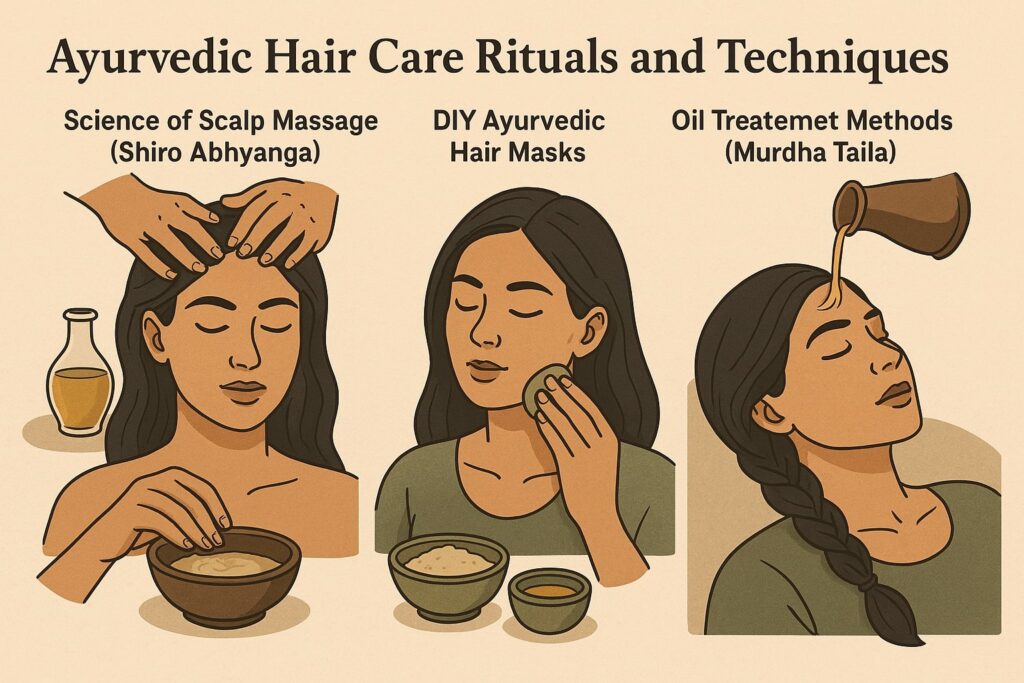
Herbs are just one part of the Ayurvedic approach to hair care. Specific techniques and rituals enhance their effectiveness and provide additional benefits.
The Science of Scalp Massage (Shiro Abhyanga)
Shiro Abhyanga, or Ayurvedic head massage, is perhaps the most effective technique for promoting hair growth. This isn’t just a relaxing indulgence – research shows that regular scalp massage increases hair thickness by improving blood circulation to hair follicles.
Step-by-step technique:
- Preparation: Warm your chosen oil (approximately 2-3 tablespoons) by placing the container in hot water.
- Oil Application: Pour the warm oil onto your palms and apply it to your entire scalp, starting from the front and moving toward the back.
- Massage Technique: Using your fingertips (not nails), massage in small circular motions with gentle to moderate pressure. Pay special attention to the crown and temples.
- Duration: Continue the massage for 5-15 minutes, ensuring the oil penetrates deeply into the scalp.
- Rest Period: Leave the oil on for at least 30 minutes (overnight is ideal) before washing.
Best oils for different hair types:
- Vata hair: Sesame oil or almond oil
- Pitta hair: Coconut oil or sunflower oil
- Kapha hair: Mustard oil or olive oil
For enhanced benefits, use medicated oils infused with herbs appropriate for your hair concerns.
DIY Ayurvedic Hair Masks
Ayurvedic hair masks provide intensive nourishment and can be customized to address specific hair concerns.
For Dry, Damaged Hair (Vata):
- 2 tablespoons yogurt
- 1 tablespoon honey
- 1 tablespoon almond oil
- 2 tablespoons amla powder
Mix all ingredients into a smooth paste. Apply to hair, focusing on dry ends. Leave for 45 minutes, then rinse with lukewarm water.
For Thinning Hair (Pitta):
- 4 tablespoons of coconut milk
- 4 tablespoons of crushed hibiscus
- 3 tablespoons of honey
- 1/2 teaspoon of bhringraj powder
Make a thick paste by mixing all ingredients. Apply to scalp and hair. Leave for 30-40 minutes before washing. This nourishing mask conditions hair while promoting growth.
For Premature Graying:
- 2 tablespoons amla powder
- 1 tablespoon bhringraj powder
- 1 tablespoon fenugreek powder
- Coconut oil (enough to make a paste)
Mix the ingredients and apply to the scalp and hair. Leave for 1 hour, then wash with a mild shampoo.
Oil Treatment Methods (Murdha Taila)
While basic oil massage is beneficial, Ayurveda offers specialized oil treatment techniques for enhanced results.
Hot Oil Treatment: Heat the oil until comfortably warm (not hot). Apply to scalp and hair, then cover with a hot towel for 15-20 minutes before washing.
Overnight Oil Application: Apply oil generously to scalp and hair, braid loosely, and cover with a shower cap. Wash in the morning with a mild shampoo.
Shirodhara Technique: While traditionally performed by Ayurvedic practitioners, a simplified version involves slowly pouring warm oil over the forehead and allowing it to flow through the hair. This deeply relaxing practice reduces stress (a common cause of hair loss) while nourishing the scalp.
Ayurvedic Diet for Healthy Hair Growth
In Ayurveda, what you eat directly impacts your hair’s health. The right diet can balance your doshas and provide essential nutrients for hair growth.
Hair-Nourishing Foods
For All Hair Types:
- Dark leafy greens (spinach, kale)
- Nuts and seeds (especially almonds and pumpkin seeds)
- Fresh fruits (particularly berries and amla)
- Whole grains
- Ghee (clarified butter)
- Sprouts and legumes
Dosha-Specific Recommendations:
For Vata Hair: Focus on warm, moist, nourishing foods like stews, soups, and healthy oils. Include sweet fruits, cooked vegetables, and warming spices like ginger and cinnamon.
For Pitta Hair: Emphasize cooling foods like coconut, cucumber, and sweet fruits. Include plenty of bitter greens and avoid excessive spicy, sour, or salty foods.
For Kapha Hair: Choose light, dry, warming foods. Include spices like turmeric and cumin, and reduce heavy, oily, or sweet foods.
What to Avoid for Better Hair
Foods That Can Aggravate Hair Problems:
- Excessive cold, frozen, or processed foods
- Refined sugar and artificial sweeteners
- Carbonated beverages
- Excess caffeine and alcohol
- Fried and junk foods
Habits That Deplete Hair Health:
- Irregular eating patterns
- Eating while stressed or distracted
- Late-night meals
- Consuming incompatible food combinations
Creating Your Ayurvedic Hair Care Routine
Consistency is key when it comes to Ayurvedic hair care. Here’s how to create a sustainable routine that fits into your lifestyle.
Daily Practices (Dinacharya)
Morning Hair Care:
- Brush hair with a natural bristle brush to stimulate the scalp and distribute natural oils
- If needed, apply a small amount of Ayurvedic hair oil to the ends
- Style your hair without using heat tools when possible
Evening Hair Care:
- Gently massage the scalp for 2-3 minutes with fingertips
- Apply oil treatment (if scheduled for that day)
- Loosely braid hair before sleeping to prevent tangling
Weekly Deep Treatments:
- Oil massage (1-2 times per week)
- Herbal hair mask (once per week)
- Herbal hair rinse (1-2 times per week)
Seasonal Adjustments (Ritucharya)
Ayurveda emphasizes adapting your routine to the seasons:
Summer Hair Care:
- Use cooling oils like coconut and sunflower
- Protect hair from sun damage with natural covers
- Increase the frequency of hair rinses with cooling herbs
Winter Hair Care:
- Switch to warming oils like sesame
- Deep condition more frequently
- Protect hair from harsh weather elements
Monsoon/Rainy Season Hair Care:
- Focus on anti-fungal herbs like neem
- Ensure hair is completely dry after washing
- Reduce oil application frequency if humidity is high
Common Questions About Ayurvedic Hair Growth
How long before seeing results with Ayurvedic hair care?
Typically, you may start seeing noticeable improvements in hair health within 6-8 weeks of regular Ayurvedic care. However, significant hair growth and texture changes usually become apparent after 3-6 months of consistent practice. Remember, Ayurveda focuses on addressing root causes, which takes time but yields sustainable results.
Can Ayurvedic remedies reverse baldness?
While Ayurvedic treatments can significantly improve hair thickness and reduce hair fall, complete reversal of baldness depends on various factors, including the cause and duration of hair loss. Ayurvedic remedies work best for early-stage hair thinning and when underlying dosha imbalances are addressed. For advanced baldness, combining Ayurvedic approaches with modern treatments may be more effective.
Are there any side effects of Ayurvedic hair treatments?
When used correctly, Ayurvedic hair treatments typically have minimal side effects. However, individual allergic reactions to certain herbs are possible. Always patch-test new ingredients and consult with an Ayurvedic practitioner if you have pre-existing scalp conditions or allergies.
How do Ayurvedic treatments compare to modern hair growth solutions?
While modern treatments often provide quicker visible results, they may come with side effects and typically stop working when discontinued. Ayurvedic approaches take longer but address underlying causes for more sustainable results. Many people find a combination approach most effective, using Ayurvedic methods for maintenance and targeted modern treatments for specific conditions.
Can I combine Ayurvedic remedies with conventional treatments?
Yes, in most cases, Ayurvedic remedies can complement conventional hair treatments. However, it’s advisable to consult with both your dermatologist and an Ayurvedic practitioner to ensure there are no contraindications. Allow sufficient time between applying different products to avoid potential interactions.
Conclusion
Ayurvedic hair growth remedies offer a holistic, natural approach to achieving healthier, thicker hair. By addressing the root causes of hair problems through herbal treatments, proper nutrition, and mindful practices, you can transform your hair’s health from the inside out.
As Deepak Chopra wisely notes, “Ayurveda teaches us that true beauty comes from balance and harmony within. When we nourish our body and mind with natural remedies, our outer appearance reflects our inner wellbeing.”
Remember that patience and consistency are essential when working with natural remedies. The journey to healthier hair through Ayurveda is not just about external treatments but also about creating balance in your overall lifestyle. By following these time-tested practices, you’re not just improving your hair – you’re embracing a holistic approach to wellness that benefits your entire being.
Are you ready to begin your Ayurvedic hair journey? Start with understanding your hair’s dosha type, incorporate one or two herbs into your routine, and gradually build a comprehensive approach that works for your unique needs. Your hair – and your overall well-being – will thank you.

